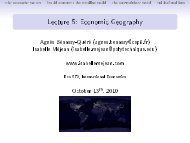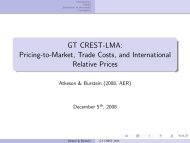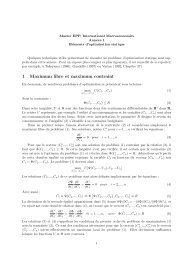Lecture 5 - Isabelle MEJEAN's home page
Lecture 5 - Isabelle MEJEAN's home page
Lecture 5 - Isabelle MEJEAN's home page
You also want an ePaper? Increase the reach of your titles
YUMPU automatically turns print PDFs into web optimized ePapers that Google loves.
Intuition<br />
Betts & Devereux (1996)<br />
Campa & Goldberg (2006)<br />
Betts & Devereux allow for PTM in a general equilibrium framework<br />
with sticky prices<br />
Pricing-to-Market: see Krugman (1987) and Dornbusch (1987).<br />
Exchange-rate fluctuations affecting the local price of exported<br />
goods may induce exporters to set different (FOB) prices in different<br />
export markets in order to smooth the impact of ER fluctuations<br />
In the paper, PTM is introduced by assuming that some firms set<br />
their price in their own currency (PCP) while some firms prefer<br />
fixing their export price directly in the importer’s currency (LCP)<br />
When ERs fluctuate and prices are sticky, PCP implies full<br />
pass-through (as Pt<br />
M = E t ∗ ¯P t X ) while LCP implies no pass-through<br />
(as ¯P t<br />
M = E t ∗ Pt X ). Under LCP, the ER risk is transferred on the<br />
firm’s mark-up while under PCP, it transmits into a risk of demand.<br />
In general equilibrium, incomplete ERPT implies that exchange rates<br />
must adjust more strongly following an asymmetric shock →<br />
Explains the high volatility of RERs with respect to the volatility of<br />
NERs.<br />
<strong>Isabelle</strong> Méjean <strong>Lecture</strong> 5









